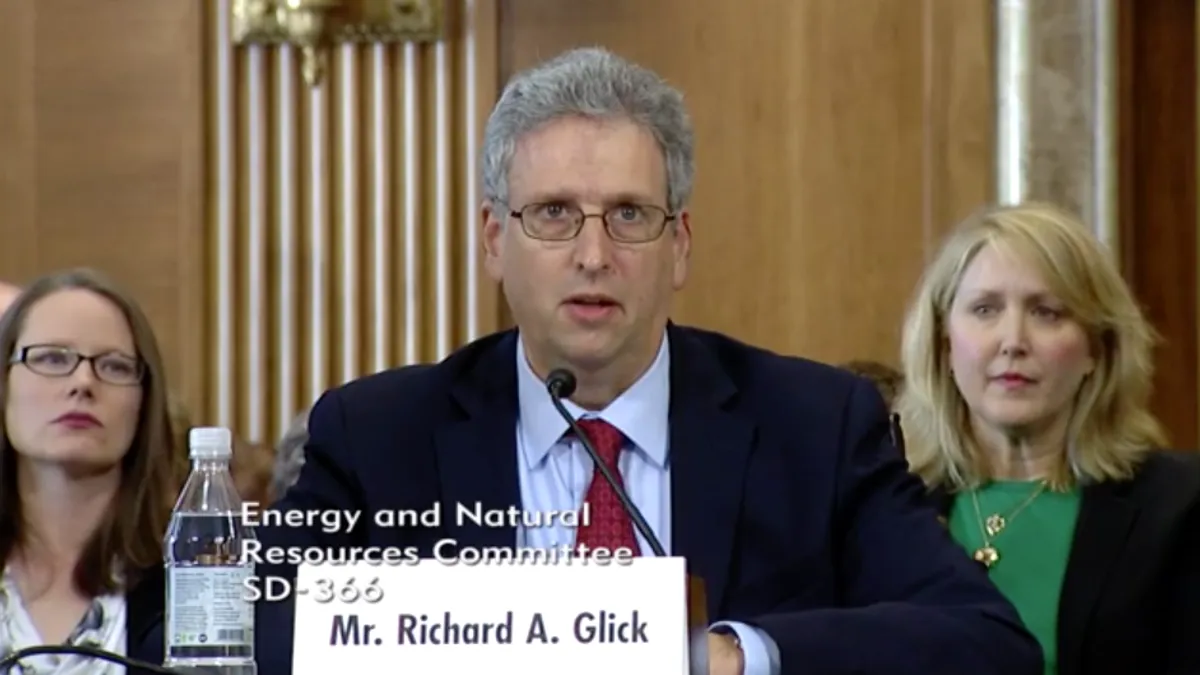Dive Brief:
- Federal Energy Regulatory Commissioner (FERC) Richard Glick highlighted the importance of federal regulatory work on energy storage hybrid projects within energy markets, among other ares of focus on Wednesday at the Energy Storage Association (ESA) policy forum in Washington.
- "We need to learn what some of the barriers are to hybrid technology," Glick said, adding that FERC should hold a technical conference on the subject.
- Some grid operators are more advanced in the treatment of storage hybrid resources: New York ISO is planning to develop a market construct before the end of the year, senior market design manager Michael DeSocio said, as the state continues work on its 3 GW energy storage goal by 2030.
Dive Insight:
Energy storage systems are increasingly being connected with solar projects, as well as wind and gas or diesel turbines. As efforts last year to create a standalone investment tax credit for energy storage did not pan out, storage developers need to pair the resource with solar if they want to benefit from that federal credit.
"I think we have a lot of hybrid resources right now in our Interconnection ... one would say that is probably driven more by federal than states at this point, with the investment tax credit," Jennifer Tribulski, senior director, Member Services at PJM Interconnection, said on an ESA panel.
Glick wants FERC to sound off on whether a project's place in the interconnection queue, as a wind or solar system, will be affected if developers add storage to it, and other storage hybrid questions, he said.
"A lot of it could also be the result of some of the aggregation rule[s] that we put in place," intended to enable solar-plus-storage and wind-plus-storage to offer more capacity to the market, Tribulski said.
Given that, PJM will "start looking at that issue more, to clarify the rules" for two resources behind the same point of interconnection, Tribulski said, without offering any timeline.
NYISO started the conversation on market definitions for hybrid resources on Jan. 13, according to DeSocio.
Similar to New York state's storage incentives, there are a number of Massachusetts state programs driving storage co-location, according to Christopher Parent, senior analyst at Exeter Associates.
The Massachusettes Department of Energy Resources and the state utility regulators have worked with ISO New England on metering environments and how hybrid facilities "would be metered both in context of the program as well as ... so those facilities can be dispatched in the market," Parent, who worked for more than 15 years within market development and operations at ISO-NE, said on the panel.
Last year, 20 MW of distributed solar-plus-storage won a bid in ISO-NE's three-year forward capacity market auction.
"ISO New England is contemplating hybrid resource models separately for the purposes of dispatch and operation in their markets," he said, adding that discussions were ongoing last year into 2020.
Enabling the full capabilities of energy storage in energy markets has been a challenge for independent system operators and regional transmission operators even as FERC allowed many of them to move forward with the implementation of Order 841, which allows storage to compete in wholesale markets.
The decision has faced legal challenges from states, including from the National Association of Regulatory Utility Commissioners (NARUC), who allege that the FERC order impinges on state authority.
The laws are "relatively clear that we have authority over sales," Glick said.
"It's not like states are powerless here, they still have authority over interconnections," he told reporters. He went on to give an example of states dictating whether an energy storage resource behind the meter can participate in the retail and wholesale market at the same time.
"The DER side of FERC Order 841 we think is really important to get through the courts," Kelly Speakes-Backman, ESA CEO, told reporters. ESA filed in support of FERC as a friend of the court on the case.
NARUC did not respond to a request for comment on the Order 841 challenge.















